Investigating the Strain, Temperature and Humidity Sensitivity of a Multimode Graded-Index Perfluorinated Polymer Optical Fiber with Bragg Grating
Abstract
1. Introduction
2. Materials and Methods
2.1. Theoretical Background on Graded Index Multimode FBGs
2.2. FBG Inscription and Optical Interrogator
2.3. Experimental Set-Up
2.3.1. Evaluation of Strain Sensitivity
2.3.2. Evaluation of Temperature and Humidity Sensitivity
3. Results and Discussion
3.1. Evolution of the FBG Spectrum during Fabrication
3.2. Sensitivity to Applied Strain
3.3. Sensitivity to Applied Temperature
3.4. Sensitivity to Applied Humidity
4. Conclusions
Author Contributions
Funding
Conflicts of Interest
References
- Zhang, C.; Zhang, W.; Webb, D.J.; Peng, G.D. Optical fibre temperature and humidity sensor. Electron. Lett. 2010, 46, 643–644. [Google Scholar] [CrossRef]
- Peng, G.D.; Chu, P.L. Polymer optical fiber photosensitivities and highly tunable fiber gratings. Fiber Integr. Opt. 2000, 19, 277–293. [Google Scholar] [CrossRef]
- Kelb, C.; Körner, M.; Prucker, O.; Rühe, J.; Reithmeier, E. PDMAA Hydrogel Coated U-Bend Humidity Sensor Suited for Mass-Production. Sensors 2017, 17, 517. [Google Scholar] [CrossRef] [PubMed]
- Rajan, G.; Liu, B.; Luo, Y.; Ambikairajah, E.; Peng, G.D. High sensitivity force and pressure measurements using etched singlemode polymer fiber Bragg gratings. IEEE Sens. J. 2013, 13, 1794–1800. [Google Scholar] [CrossRef]
- Hu, X.; Fung, C.F.J.; Tam, H.Y.; Mégret, P.; Caucheteur, C. Tilted Bragg gratings in step-index polymer optical fiber. Opt. Lett. 2014, 39, 6835–6838. [Google Scholar] [CrossRef] [PubMed]
- Aressy, M. Drawing and Mechanical Properties of Plastics Optical Fibres; Birmingham University: Birmingham, UK, 2006. [Google Scholar]
- Bayer Material Science AG. Optical Properties of Makrolon and Apec for Nonimaging Optics; Bayer Material Science AG: Leverkusen, Germany, 2014. [Google Scholar]
- Brandrup, J.; Immergut, E.H.; Grulke, E.A. Polymer Handbook, 4th ed.; John Wiley & Sons, Inc.: New York, NY, USA, 1999; ISBN 0-471-16628-6. [Google Scholar]
- Oliveira, R.; Bilro, L.; Nogueir, R. Bragg gratings in a few mode microstructured polymer optical fiber in less than 30 s. Opt. Express 2015, 23, 10181–10187. [Google Scholar] [CrossRef] [PubMed]
- Ma, H.; Jen, A.K.Y.; Dalton, L.R. Polymer-based optical waveguides: Materials, processing, and devices. Adv. Mater. 2002, 14, 1339–1365. [Google Scholar] [CrossRef]
- Koike, Y.; Asai, M. The future of plastic optical fiber. NPG Asia Mater. 2009, 1, 22–28. [Google Scholar] [CrossRef]
- Peng, G.D.; Philip, N.J.; Wang, T. Development of special polymer optical fibers and devices. Int. Soc. Opt. Photon. 2004, 5595, 138–153. [Google Scholar] [CrossRef]
- Ando, S.; Matsuura, T.; Sasaki, S. Perfluorinated polymers for optical waveguides. Chem. Tech. 1994, 24, 20–27. [Google Scholar]
- Liu, H.Y.; Peng, G.D.; Chu, P.L.; Koike, Y.; Watanabe, Y. Photosensitivity in low-loss perfluoropolymer (CYTOP) fibre material. Electron. Lett. 2001, 37, 347–348. [Google Scholar] [CrossRef]
- Ishigure, T.; Koike, Y.; Fleming, J.W. Optimum index profile of the perfluorinated polymer-based GI polymer optical fiber and its dispersion properties. J. Light. Technol. 2000, 18, 178–184. [Google Scholar] [CrossRef]
- Koerdt, M.; Kibben, S.; Hesselbach, J.; Brauner, C. Fabrication and characterization of Bragg gratings in a graded-index perfluorinated polymer optical fiber. In Proceedings of the 2nd International Conference on System-Integrated Intelligence: Challenges for Product and Production Engineering, Bremen, Germany, 2–4 July 2014; pp. 133–141. [Google Scholar]
- Koerdt, M.; Kibben, S.; Bendig, O.; Chandrashekhar, S. Fabrication and characterization of Bragg gratings in perfluorinated polymer optical fibers and their embedding in composites. Mechatronics 2016, 34, 137–146. [Google Scholar] [CrossRef]
- Lacraz, A.; Polis, M.; Theodosiou, A.; Koutsides, C.; Kalli, K. Femtosecond laser inscribed Bragg gratings in low loss CYTOP polymer optical fiber. IEEE Photon. Technol. Lett. 2015, 27, 693–696. [Google Scholar] [CrossRef]
- Alejandro, C.; Miguel, A.M. Growth Modeling of Fiber Gratings: A Numerical Investigation. Fiber Integr. Opt. 2002, 21, 451–463. [Google Scholar] [CrossRef]
- Mizunami, T.; Djambova, T.V.; Niiho, T.; Gupta, S. Bragg Gratings in Multimode and Few-Mode Optical Fibers. J. Lightwave Technol. 2000, 18, 230–235. [Google Scholar] [CrossRef]
- Olshansky, R. Propagation in glass optical waveguides. Rev. Mod. Phys. 1979, 51, 341–367. [Google Scholar] [CrossRef]
- Webb, D.J. Fiber Bragg grating sensors in polymer optical fibers. Meas. Sci. Technol. 2015, 26, 092004. [Google Scholar] [CrossRef]
- Stajanca, P.; Lacraz, A.; Kalli, K.; Krebber, K. Strain sensing with femtosecond inscribed FBGs in perfluorinated polymer optical fibers. Int. Soc. Opt. Photon. 2016, 9899, 989911. [Google Scholar] [CrossRef]
- Bremer, K.; Weigand, F.; Zheng, Y.; Alwis, L.S.; Helbig, R.; Roth, B. Structural Health Monitoring Using Textile Reinforcement Structures with Integrated Optical Fiber Sensors. Sensors 2017, 17, 345. [Google Scholar] [CrossRef] [PubMed]
- Wu, Y.; Stefani, A.; Bache, M.; Jacobsen, T.; Rose, B. Improved thermal and strain performance of annealed polymer optical fiber Bragg gratings. Opt. Commun. 2011, 284, 176–182. [Google Scholar] [CrossRef]
- Saez-Rodriguez, D.; Nielsen, K.; Rasmussen, H.K.; Bang, O.; Webb, D.J. Highly photosensitive polymethylmethacrylate microstructured polymer optical fiber with doped core. Opt. Lett. 2013, 38, 3769–3772. [Google Scholar] [CrossRef] [PubMed]
- Liu, H.Y.; Peng, G.D.; Chu, P.L. Thermal tuning of polymer optical fiber Bragg gratings. IEEE Photon. Technol. Lett. 2001, 13, 824–826. [Google Scholar] [CrossRef]
- Zhang, W.; Webb, D.J.; Peng, G.D. Investigation into time response of polymer fiber Bragg grating based humidity sensors. J. Lightwave Technol. 2012, 30, 1090–1096. [Google Scholar] [CrossRef]
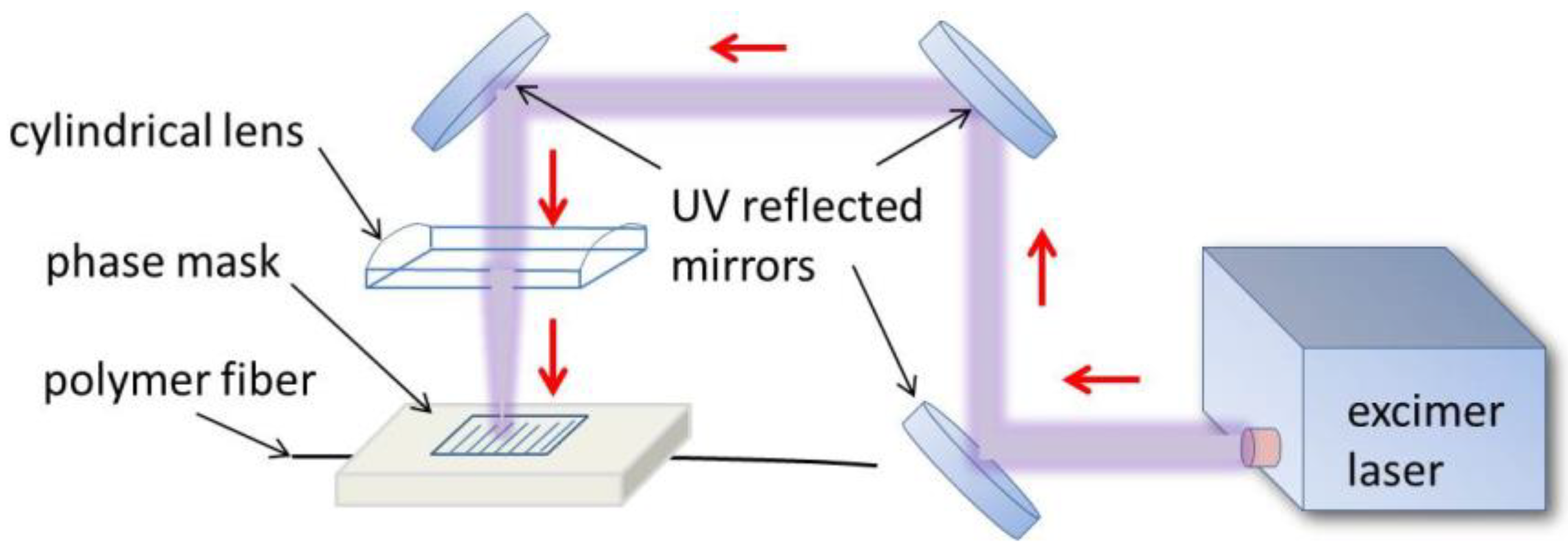

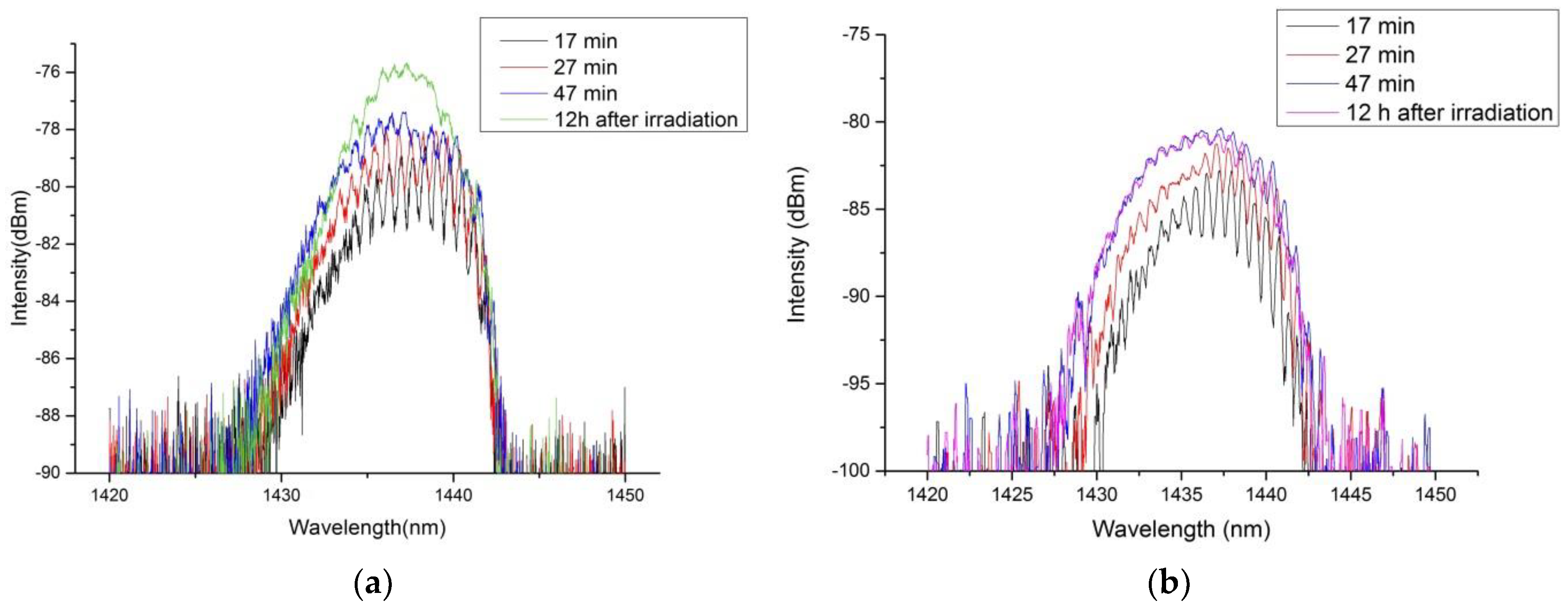

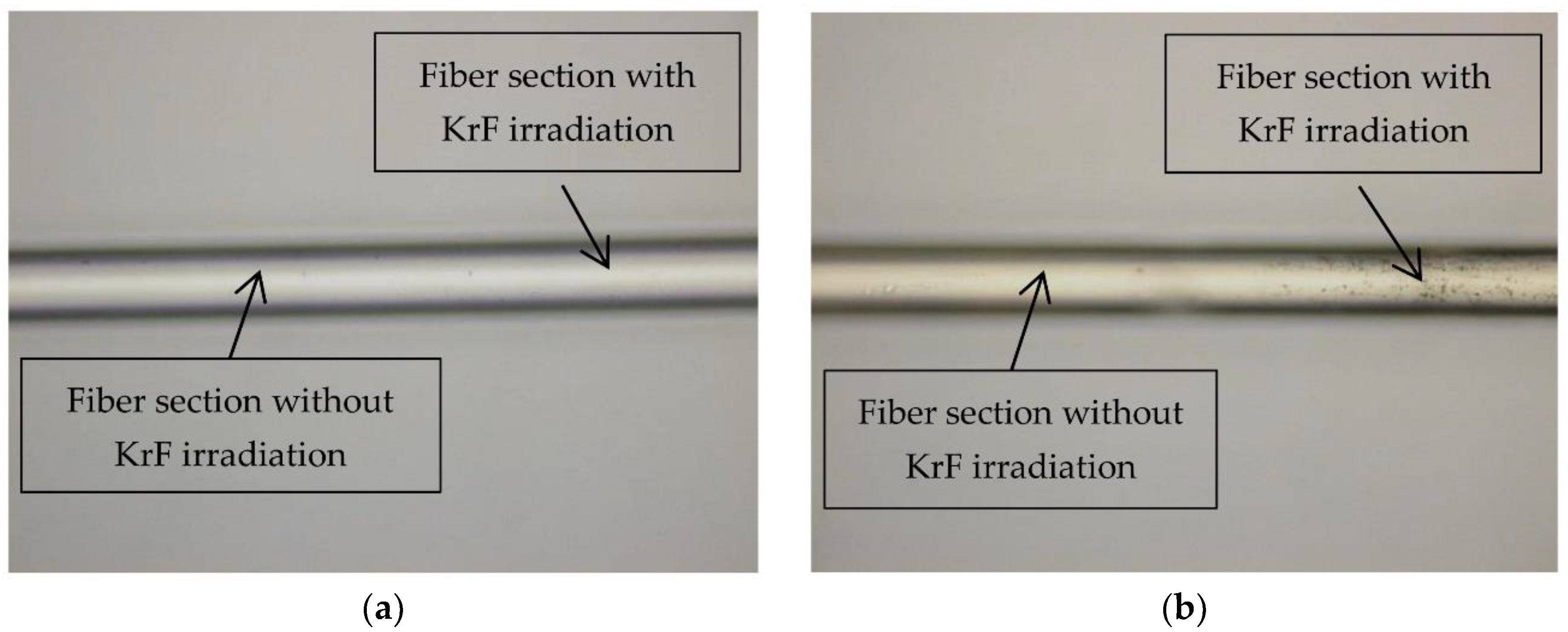
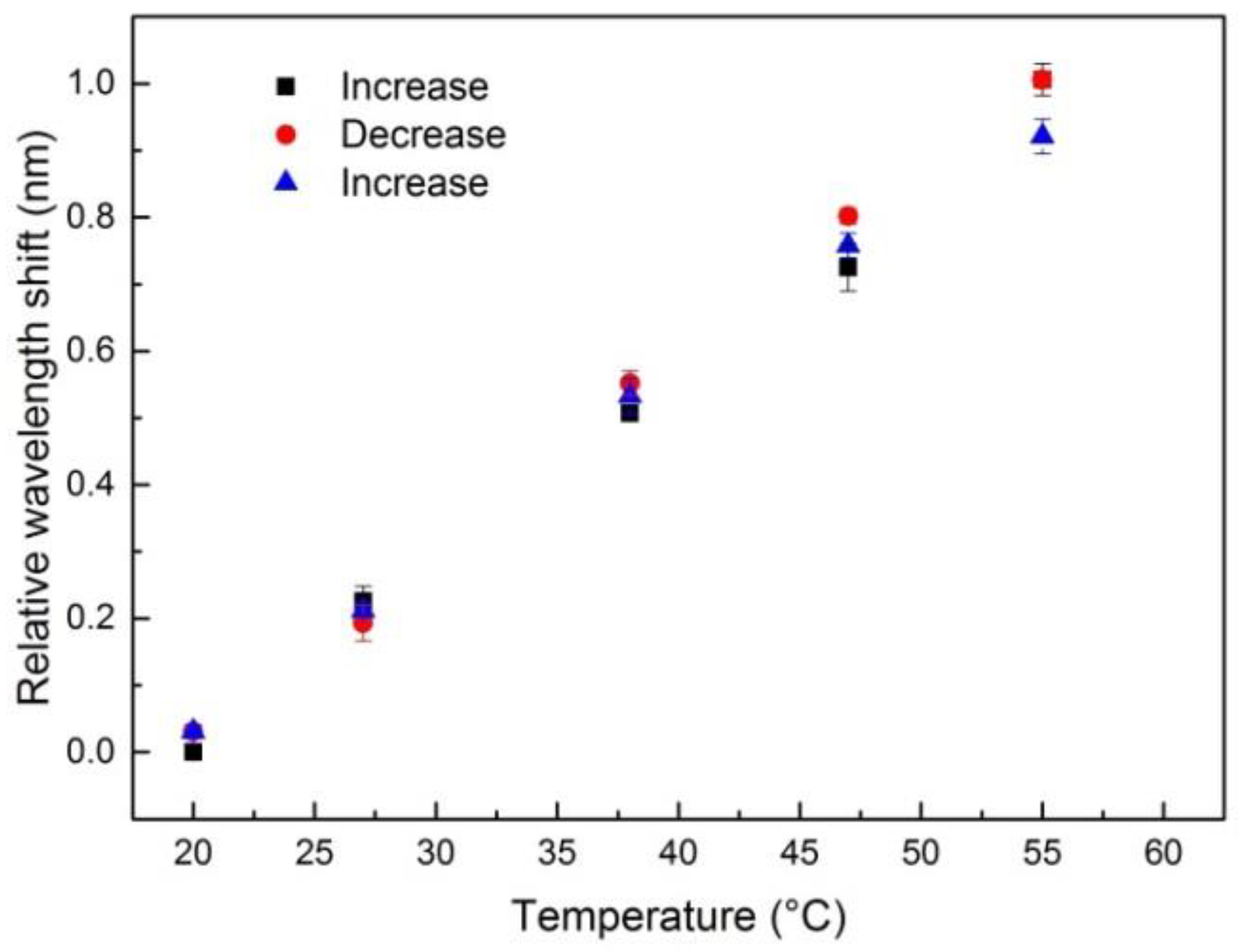
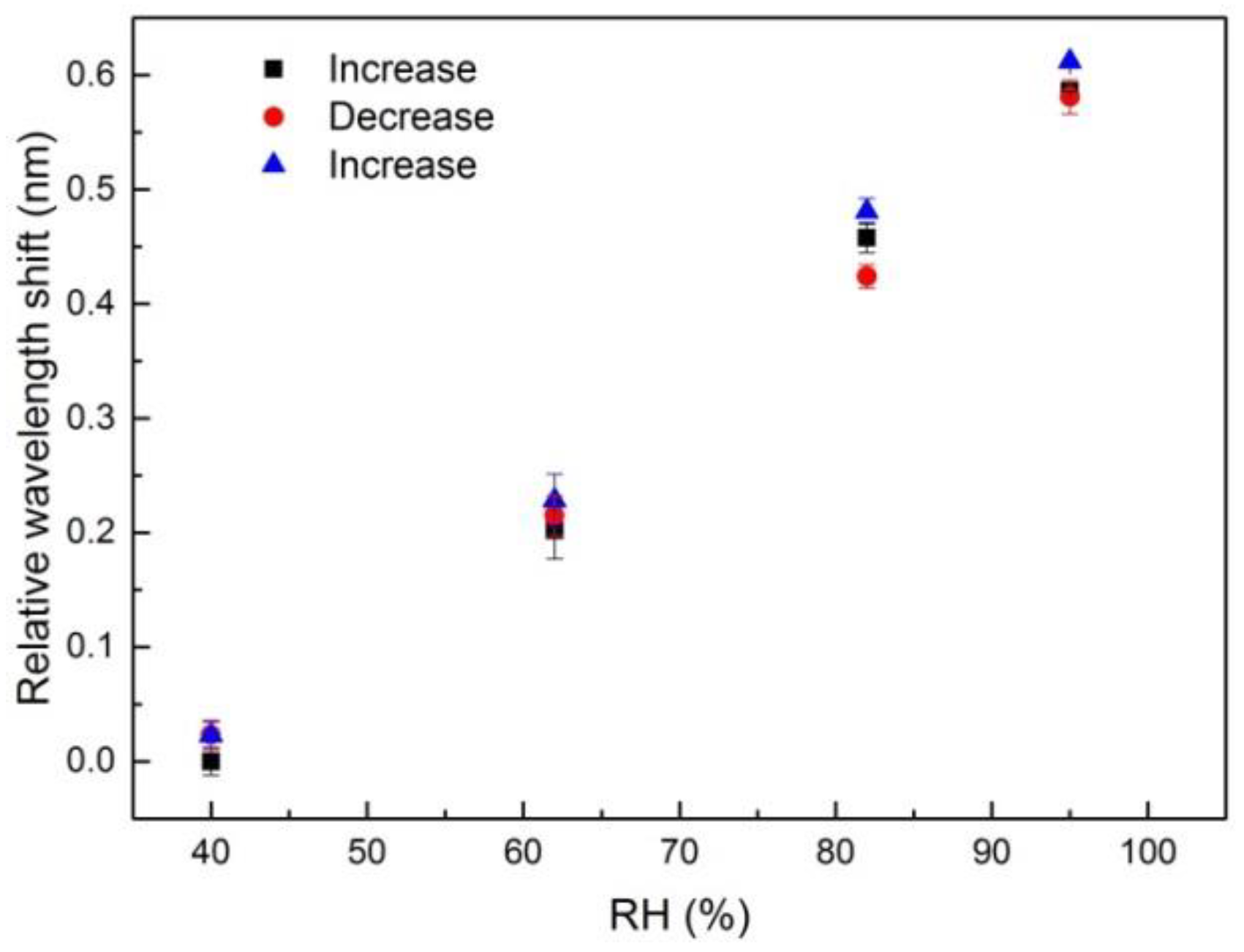
| Sample | Irradiation Time (min) | Repetition Rate (Hz) | Sensitivity (nm/mε) | Failure Strain (mε) | Sample Length (mm) |
|---|---|---|---|---|---|
| 1 | 47 | 40 | 1.506 ± 0.021 | 7 | 78 |
| 2 | 30 | 20 | 1.509 ± 0.071 | 18 | 79 |
| 3 | 10 | 20 | 1.577 ± 0.097 | 25 | 79 |
© 2018 by the authors. Licensee MDPI, Basel, Switzerland. This article is an open access article distributed under the terms and conditions of the Creative Commons Attribution (CC BY) license (http://creativecommons.org/licenses/by/4.0/).
Share and Cite
Zheng, Y.; Bremer, K.; Roth, B. Investigating the Strain, Temperature and Humidity Sensitivity of a Multimode Graded-Index Perfluorinated Polymer Optical Fiber with Bragg Grating. Sensors 2018, 18, 1436. https://doi.org/10.3390/s18051436
Zheng Y, Bremer K, Roth B. Investigating the Strain, Temperature and Humidity Sensitivity of a Multimode Graded-Index Perfluorinated Polymer Optical Fiber with Bragg Grating. Sensors. 2018; 18(5):1436. https://doi.org/10.3390/s18051436
Chicago/Turabian StyleZheng, Yulong, Kort Bremer, and Bernhard Roth. 2018. "Investigating the Strain, Temperature and Humidity Sensitivity of a Multimode Graded-Index Perfluorinated Polymer Optical Fiber with Bragg Grating" Sensors 18, no. 5: 1436. https://doi.org/10.3390/s18051436
APA StyleZheng, Y., Bremer, K., & Roth, B. (2018). Investigating the Strain, Temperature and Humidity Sensitivity of a Multimode Graded-Index Perfluorinated Polymer Optical Fiber with Bragg Grating. Sensors, 18(5), 1436. https://doi.org/10.3390/s18051436







